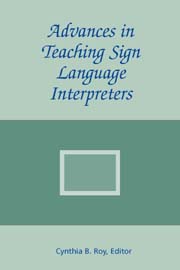Cynthia B. Roy, Editor
Foreword by Franz Pöchhacker
|
View the table of contents. View the list of contributors. Read the foreword. Read the introduction. Read an excerpt. Read a review. |
$63.25s print edition $63.25 e-book |
Interpreter Education, Volume 2
From Interpreting, International Journal of Research and Practice in Interpreting, cont’d.
The second contribution, by Jeffrey E. Davis, discusses the teaching of observational skills. After providing a brief overview of complementary pedagogical approaches (discourse analysis, ethnography of communication and participant observation), he describes Dean and Pollard’s (2001, 2005) descriptive and analytic Demand-Control schema: Demands (D) being the contextual factors encountered by interpreters, including Environmental, Interpersonal, Paralinguistic and Intrapersonal (EIPI) factors, whereas Controls (C) are features brought into play before, during or after an interpreting assignment, such as prior experience or education. He gives a detailed description of a 3-year project carried out from 2001 to 2004 at the University of Rochester Medical Center and the University of Tennessee, where the D-C schema was implemented across a range of in-class and out-of-class interpreting situations to provide a realistic understanding of the contextual factors through observation of settings and interpretation. Out-of-class observations also involved non-interpreted events within the Deaf community, thus covering a wide variety of real-life monologic and interactive contexts with the D-C schema.
The American co-authors of the third paper, Elizabeth A. Winston and Christine Monikowski, endorse the importance of mastering translation as the key to good interpretation. They introduce the concept of discourse mapping — the creation of a map of a text without words — and then go on to discuss a series of activities to illustrate how to ‘map for translation’. This involves a video pre-showing of a signed source text. Interpreters were asked, after 3 to 5 days, to forget specific signs and recall only the concepts and ideas. They then started mapping the text intralingually, ASL (American Sign Language) to ASL, by generating a randomly ordered concept map according to their memories of the text, and were thus detached from the immediate influence of the source language. The resulting map, composed of the visual representation of the source text, focused on major events and not on the details. From this map, individual sequential maps were produced from the seemingly random chaos to create logical meaning, each with slightly different detail and differently grouped ideas. A written English translation was then derived from the map, without the time constraint of interpreting. This led to group discussion and comparison of the complex linguistic forms in the source and target texts, especially those sections predicted to pose greater problems, such as the use of ASL classifiers and repetition for emphasis. This seems a most interesting cognitive exercise in order to bridge the visual/aural-oral divide.
Laurie Swabey explores the question of referring expressions, which are omnipresent in sign language. They depend greatly on their context for meaning, and may easily become ambiguous and especially difficult to grasp when more than one referent is involved in signed discourse or when the signer switches from interpreting one narrative to another. Swabey explains that American interpreter trainees tend to rely on their knowledge of English referencing patterns by using the pronominal system, but in ASL one can refer to entities in multiple ways. It is important that students be taught the difference between given and new information. Pronouns have a high degree of ‘givenness’ which students find difficult to comprehend accurately, losing subtle references to entities such as those that involve eye gaze. Two teaching-learning approaches are described in detail, using video and language analysis activities in order not to focus on interpreting but on language knowledge and proficiency in the use of referring forms.
Cynthia B. Roy is a retired professor in the Department of Interpretation and Translation at Gallaudet University, where she directed the BA program and the PhD program. She is also a nationally certified American Sign Language–English interpreter specializing in community interpreting.
Print Edition: ISBN 978-1-56368-320-6, 6 x 9 casebound, 224 pages, tables, figures, references, index
$63.25s
E-Book: ISBN 978-1-56368-391-6
$63.25
To order by mail, print our Order Form or call:TEL 1-800-621-2736; (773) 568-1550 8 am - 5 pm CST
TTY 1-888-630-9347
FAX 1-800-621-8476; (773) 660-2235
